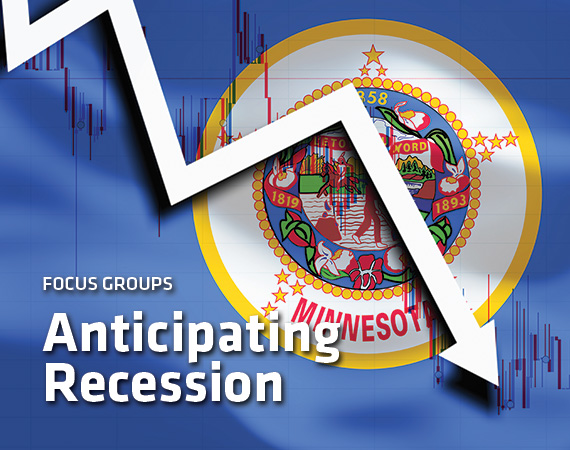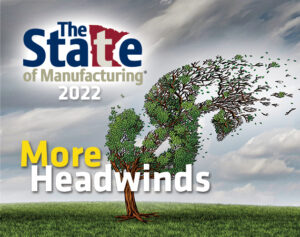Enterprise Minnesota: How optimistic are you about the next 12 months? Do you see yourselves being more profitable, less profitable or is it difficult to predict?
[Focus Group participant]: We’re very optimistic as far as growth, as far as profitability. We have some internal developments bringing on new product lines, but we also appear to be picking up business from other similar suppliers that couldn’t keep their customer service levels up.
We’re pretty optimistic about the business environment. We’ve come off two really, really big years. Probably like a lot of folks, we don’t have all our roles filled, so that may be one element that kind of holds us back a little bit. But we’re pretty optimistic about the future.
I’d say we’re very optimistic about the future. We’re having a record-setting year this year, in part because we have had other competitors who haven’t been able to fulfill customer needs, and so we’ve been able to shift some business our direction, and that is serving us well. And we’ve had some early successes in staffing, an area where a lot of other companies have been challenged. We have seen very large growth this year and are anticipating growth over the next 12 months.
We’re anticipating an uptick in the next 12 months. We’re strong on where we’re going because of the work we’ve done this year, such as developing new customers. We’ve been staffed appropriately since 2020. One of the initiatives that came out of our strategic review was automation. We’ve been waiting for a customer to come to us with the product and then we’d invest in automation, but we have to flip that around. We have to invest in automation and then go get the work is what we’re thinking.
I’m not optimistic or pessimistic. I think business seems to be pretty good. I think if you have the labor, you’re able to pick up a business from other locations. However, I do have concerns about the economy. There’s just uncertainty in that area. Doesn’t take much.
Enterprise Minnesota: How do you plan for two or three years out in this kind of a world?
Most of our suppliers right now are asking for a 2023 forecast, and some of them are asking for a 2024 forecast, which I don’t have a crystal ball for, and I don’t know if anyone here does. So, it’s been a very difficult challenge to try to project what our growth is for even just next year on top of thinking about years after that.
We had a really good strategy going into 2022, and then the war with Ukraine started. Our products are entirely based on a plywood material that comes from the Baltic region, which neighbors Russia. So as of March, that material is no longer coming out of the Russian ports because all the shipping companies stopped going there. Everything that we had planned for the year has changed. Now we have to stockpile this material, put all of our cash into that and then start figuring out what to do if we can’t get it anymore. Planning right now is really hard.
Has there been any business lost due to price increases or inflation?
With some of our customers, it was easy to pass on those price increases. With others, it’s been a battle. It’ll be interesting to see what the future holds with our customers who we are not able to pass price increases onto.
I would say we’ve had a very small group of customers who have pushed back hard on price increases. I think part of that is just being a good buyer. A good buyer is always going to challenge those price increases in any market.
We increased what we refer to as our strategic inventory, or our protective inventory, probably 25% this last year. It’s good inventory. It’s not going to expire, we’re not at risk of the customer not wanting it anymore. It’s allowed us to keep running every single day. And it’s really allowed us to grow our sales because we’ve got this stuff.
We’ve been purchasing equipment where it makes sense for us. Our industry is really kind of labor intensive anyways, just for the material that we’re working with, but where we can, we try to automate as much as possible. We’ve been looking at where it makes sense for cobots, that sort of thing.
Last year, the State of Manufacturing® for the first time in its history revealed the number one issue for manufacturers was attracting and retaining talent. Is that your experience?
For us, retention has been good, as of late. We bought the company last November and up until that point retention was a definite issue, certainly throughout COVID. I would just say that the rules have changed. I’ve led many manufacturing businesses for a couple of decades. Flexible schedules, variety of benefit packages, apprenticeships or intern programs, not just with colleges, but with high schools, pulling out all the stops to get people and being completely flexible in how you approach those relationships as an employer is the new norm. Such things are no longer considered going above and beyond. They are the baseline expectations. And whether we blame COVID or millennials or both or something else, I don’t really know what the driver is, but I think our successes in retention have been from doing all of those things. Pulling out all of the stops and just being, in my opinion, almost ridiculously flexible. That is the new workforce.
We’re pursuing all of that as well. And regarding automation, that’s why we’re looking at it. Not because we haven’t previously considered it for efficiency, but because now we’re concerned that we won’t have the bodies we need. We’re looking at what jobs are hardest, the jobs that people don’t want to do, and seeing if we can figure out how to automate those. So we’re doing all the same types of things — trying to create a great workplace culture, an interesting place to work in the manufacturing industry, offer flexibility. But you can only stretch so far. I do know that the state of Minnesota needs to get better at recruiting people to come live in this state. I don’t know exactly how that gets done, but our business and our state are in competition with everybody else. From my perspective, we have to get more people interested in coming into our universities, our schools, our communities. Otherwise, we are in trouble.
We’re limited not by machinery but by people, as far as our growth goes. We currently have about 12 people on our night shift, so that’s really where we are trying to grow, but it’s very difficult to add people to that shift. So, we have to be creative with the ways that we attract people, and that’s always ongoing. To be an attractive employer, you have to offer good benefits, be creative in wages, and it has become very competitive in the area for wages. I’m hearing some employers are giving a 10% boost right off the bat. And just trying to retain employees is really important to us. We do that through our profit-sharing program, which is going to be important for us going forward so that we continue to grow and be competitive in our industry and keep our lead times at three to four weeks or less.
Given that it’s costly to replace employees, could you be doing even better if you didn’t have to be on the chase for new people?
I do think that payroll and personnel costs are going to be a big driver of our overall cost of business. We made pretty aggressive changes in wages last year, and we anticipate pretty aggressive changes in wages this year. We anticipate we will pass that on in pricing, but someday that pricing opportunity is going to get much, much harder. So, I do think the cost of people — as we look forward into the future — is going to be a fairly significant pressure point on overall operating profits.
The approach that we’re taking is that we believe we have premium products, and we want to attract premium people. To do that, we need benefits that are in line with that. So, we’ve improved a number of our benefits already and more will be rolling out the first of the year, which has a price tag to it. But just like the approach we’re taking with inventory: If you don’t have the people, or if you don’t have the inventory, you also don’t have the sales.
There’s a subcontractor of ours in the metro area that has gone to a model of nearly 100% of employees on work visas. They work with a broker and bring the employees up from Mexico and house them. They do pay them a significantly lower hourly wage as part of that housing program, but they have staffed their entire facility, which is a nearly fully automated facility. That is the only way that they say they can be competitive, from a cost standpoint.
For retaining, we do similar stuff to what everyone else is doing — the four-day work week, there’s some days they’re at home and some days they’re in the office, the luncheons and the little picnics, we just have to get some type of team cohesion. We try to stay competitive with our benefits package. We do a 401k match. We also do profit sharing on a quarterly basis. But it does come down to hourly wages. And like I said before, we’re having a difficult time passing on those wage increases to some of our customers.
The four-day work week feels like it’s becoming more of the norm for a lot of manufacturers that work with us. I think the role of HR, too, has changed tremendously in the last few years. It has become more important than ever. And it has a high burnout rate, as well. I read an article that 18 months is the standard timeframe for HR professionals. So just looking at who’s taking on what tasks and what’s their workload capacity, making sure that employees can stay productive but aren’t drowning. I think we see a lot of that too.
What are you doing to pay attention to cybersecurity issues?
We were in a ransom situation in September of last year. Basically, Russians hacked nine companies in a week. We didn’t pay the ransom, and thankfully they didn’t corrupt our systems. They did, though, take lots of data. Thankfully none of the personal data has been used so far. We learned that up until that point, we were trying to prevent hackers. We’ve switched our approach to expecting we are going to be hacked, and asking how do we protect our business so that we can operate the next day? We’re putting firewalls and multifactor authentication and all these other pieces in place, but we are anticipating that someone’s going to hack us, and we want to be able to operate the next day. It’s a completely different approach as it relates to protecting your systems. Don’t get me wrong — we’re trying to keep people out. But we think the hackers are faster than the software security suppliers. We’re phishing testing our employees every 30 days, and then those who fail the phishing test go through training. We have about 10% of our employees who we’ve trained over and over and over, and they keep making the same mistakes. We are working really hard to try and not get hacked, but at the same time, we’re just assuming we’re going to get hacked.
We have some phishing testing through our security provider. We have some old computers, so they do a quarterly review to see if they can get into our systems or not. I’m grateful to Enterprise Minnesota for connecting us with people who help us do that. And then of course the other side of that is the NIST SP 800-171, which is if you do business with the federal government or their employees that are subcontractors, you have to be able to secure your networks. And that’s quite aggressive. So that’s what we’re doing.
We are doing multiple authentications, but we are also asking what can we do to protect our data? We have backups, whether it’s internal or external. So, if somebody does corrupt our servers or whatnot, basically we can toss those out, put new ones in, resecure and download our data. We might lose an hour or two worth of input, but we’re still up and running relatively quick.
We’ve done some training here, but I don’t know how effective it was. I passed, but I think the biggest thing that we’re doing is we’re not relying on ourselves to do it. We have a firm that manages probably 90% of related things. I’ve learned in the past that these firms have a person or two who is just 100% focused on cybersecurity. I don’t know if the company we’re working with is the best, but I definitely agree it’s the right approach to go with somebody like that.
What did COVID teach you and your organization? How do you plan on applying that going forward?
Adapt and adapt quickly.
We tried being very responsive. As a manager, as a leader, you have to try and listen to all your employees, and that was very challenging. But I don’t see it as that much different than right now. You still have to listen to the employees’ needs, what they want, what they’re thinking, even though hopefully we’re beyond that crisis. Now we’ve got an employment crisis. Tomorrow there will probably be some other crisis. So, it’s more of listening and doing the right thing as a leader.
…
Featured story in the Winter 2022 issue of Enterprise Minnesota magazine.


